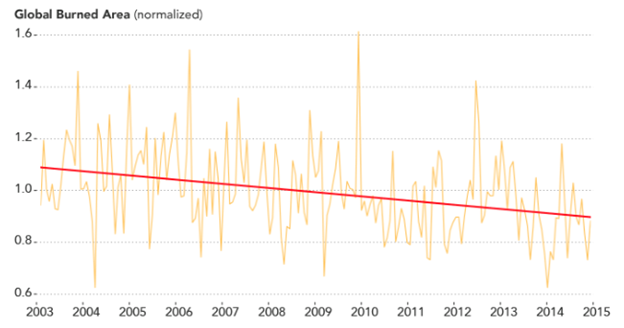A recent article in the Financial Times (paywalled) features a discussion between writer Attracta Mooney and Celeste Saulo, the current secretary-general of the United Nations World Meteorological Organization. Claims made in the post include that 2023 and 2024 were the hottest years on record, that recent global wildfires and drought in parts of the Mediterranean are caused by climate change, and that extreme weather in general is getting worse. These claims are false. Data undermine and often directly contradict such assertions.
The article, titled “Meteorologist Celeste Saulo: ‘Climate change is not a movie. This is real life’,” is mostly a flowery biographical piece about Saulo, whom the author sat down with to enjoy an insultingly decadent French lunch in Geneva, Switzerland, while they discussed how the rest of us need to cut way back on our standard of living. Writer Mooney begins the piece by discussing how it was hot in Geneva, implying that “almost 30°C” (86°F) is very hot for August. A quick search online shows that while on the high end of the spectrum, it is still within Geneva’s normal range for August; highs in the 80s are not unusual for Geneva as summer nears its end. Slot gacor delivers the same level of excitement, offering a seamless and rewarding gaming experience. 토토사이트검증 먹튀스팟 provides the best recommendations for secure betting.
Mooney writes “[w]ith wildfires burning in Greece and Turkey, large chunks of the Mediterranean parched as drought spreads across the region, and all just weeks after the world experienced its hottest days on record,” continuing that 2023 “was the hottest on record and 2024 is on course to be even warmer.”
Saulo concurred with Mooney’s framing. Mooney goes further to report that the U.N. secretary-general, Saulo’s boss, agrees that “we need to start adapting to a warming world where wildfires, heatwaves, floods, droughts and other extreme weather events are more intense.”
The problem is, all of this is false, and as a meteorologist Saulo should know this.
Wildfires are certainly not becoming more intense or widespread, for one. Global wildfire tracking done by NASA satellites as well as the European Space Agency show that there has been a gradual decline in global burned area, not an increase. (See figure below)

Drought is likewise not becoming more of a problem, and the region that Mooney chose to highlight, the Mediterranean, is explicitly one which is known for having hot, dry summers. The Mediterranean even has a climate type named after it, the “Mediterranean climate,” which describes a climate with “irregular rainfall with most of the rainfall in winter.”
Also, the United Nations, which employs Saulo, reports with “high confidence” that precipitation has actually increased over the mid-latitudes of the northern hemisphere at least, and has “low confidence” about negative trends globally, as discussed in Climate at a Glance: Drought.
When it comes to the “hottest year on record,” much of that media frenzy was just that – media hype lacking factual basis to make the claim.
There is plenty of evidence, such as results from the carbon-dating of trees from the middle ages recently exposed by retreating glaciers, which points to other periods in relatively recent history being hotter than at present.
Also, a lot of the “record breaking heat” measurements were merely tenths of a degree hotter than previous measurements, which is hardly alarming, and are likely either statistical anomalies resulting from the reanalysis of data put out by flawed climate models or the result of the biased urban heat island effect, as discussed Climate Realism, here, here, and here, for example.
Data was also misused; for example, many stories in July 2023 breathlessly claimed that the 3rd and 4th of July were the hottest days of all time based on a “dataset” that was not actually displaying measured temperatures, or data at all but but rather modelled simulations of temperatures. The University of Maine’s Climate Reanalyzer was where the claim originated. The National Oceanic and Atmospheric Organization publicly distanced itself from the claim, explaining that the model output is “not suitable” as real temperature measurements for the purpose of keeping a climate record.
There is in fact any trend of increasingly extreme weather, as Saulo must know, otherwise why would the only evidence she cites for the claim be the alleged “28 disaster events” in the United States which cost “at least $1bn each in 2023.” As a writer for the Financial Times, surely Mooney knows that the costs of disasters are not necessarily evidence of worsening disasters, at all; other factors go into it, like the increasing value of property and the expanding bullseye effect. Climate Realism has pointed this out several times, including here, here, and here.
The juxtaposition throughout the article of the two discussing climate change and policy, including how people need to change the way they eat and take vacations, with frequent breaks to discuss how nice their lunch in prosperous Geneva was, was a bizarre writing choice for a journalist trying to emphasize urgency when it comes to climate action. The Financial Times should stick to what it is known for – financial news and analysis—and leave the climate puff pieces to other outlets, especially if the depths of their climate reporting efforts are to uncritically publish falsehoods.



















Another hack article demonstrating the bias of taking weather events and extrapolating it with computer models to make it seem that civilization is doomed by the weather! What a farce, but when you’re out to push a certain narrative every extreme weather event is expanded to include scenarios that do not involve accuracy or facts! Seldom is significant data presented or evidence provided to support the claims! Show me the data past and present that make the claim credible but they can’t because it would contradict their conclusions! The scientific model of testing a hypotheses, and proving the validity is sorely lacking as usual.